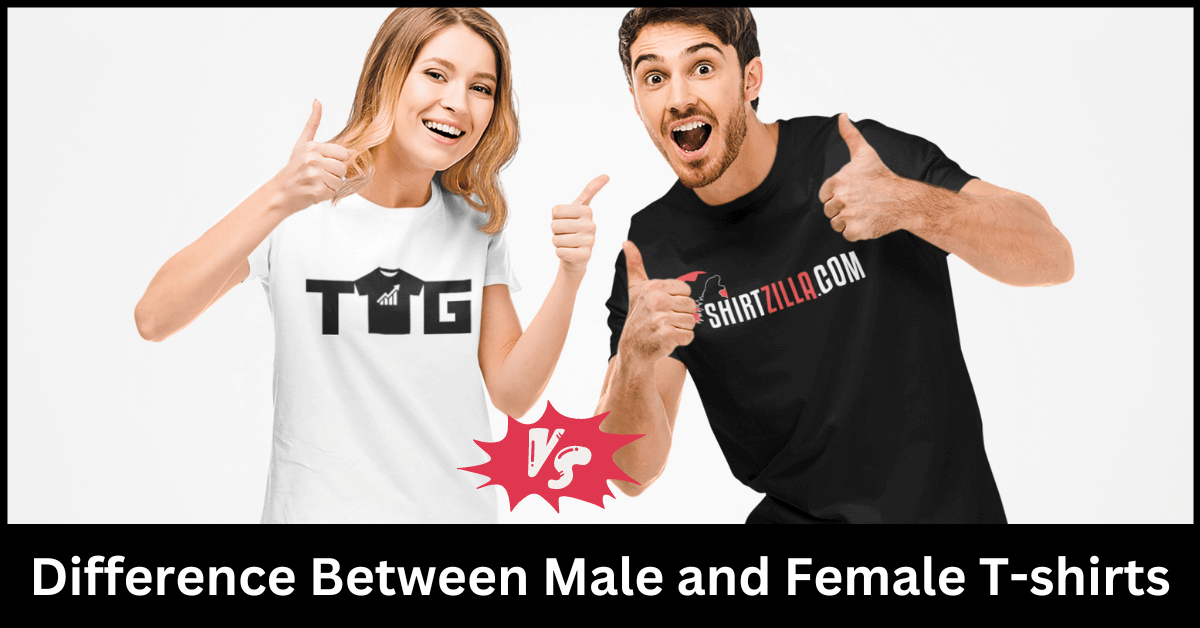Have you ever stopped to consider the subtle yet significant difference between male and female t-shirts? Understanding these differences is crucial to your business, as it can help you cater to your customer’s needs more effectively and ultimately sell more shirts.
There are eight key differences between male and female t-shirts. These include the cut of the waist, the flare at the hips, the length and fit of the sleeves, and the style of the neckline. But that’s not all! The sizing, overall fit, and even the fabric used can vary between genders.
By understanding the difference between men’s and women’s t-shirts, you can better cater to your customers, providing them with t-shirts that not only look good but also feel comfortable and fit well. This knowledge can be a game-changer in your t-shirt selling business, helping you to stand out in a crowded market.
So, are you ready to dive deeper into each of these differences and learn how to use this knowledge to your advantage? Let’s get started and take your t-shirt business to the next level!
Men’s vs Women’s T-shirts: Are Unisex Shirts Really Unisex?
A Unisex shirt means that both men and women can wear them. However, we have found that Unisex sizing caters more to men than women. If you are wondering how a unisex shirt will fit, it is very similar to how a men’s t-shirt fits.
In our experience, unisex sizing tends to lean more toward men’s sizing. This is likely because men’s bodies, on average, are larger and have different shapes compared to women’s bodies. Therefore, when a shirt is labeled as unisex, it often -means that it has been designed with a more straight-cut style, similar to men’s t-shirts. This design typically lacks the tapering or contouring that is often present in women’s t-shirts to accommodate for a narrower waist and wider hips.
Waist Cut: Difference Between Men’s and Women’s T-shirts
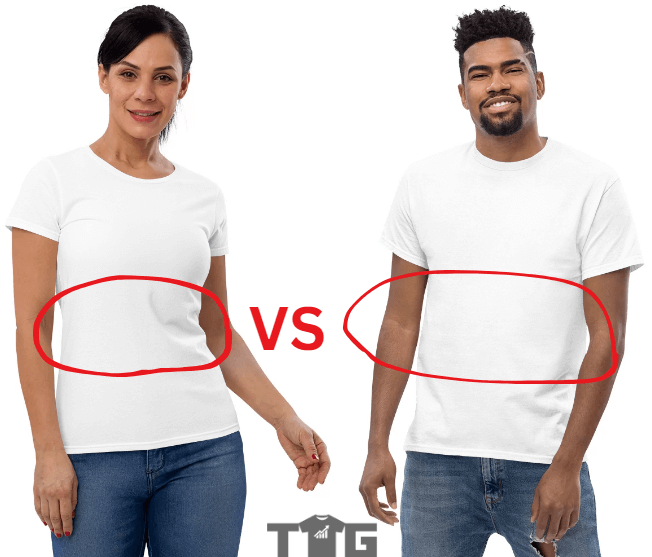
One of the most obvious differences between male and female torsos, when seen from the front, is the waist. While men’s torsos will tend to be largely straight from top to bottom, women will have narrower waistlines compared to the rest of their torsos.
Unisex or Men’s t-shirts worn by women would often leave a whole lot of material sitting loose or getting bunched up in unsightly ways. To prevent this, women’s t-shirts are cut narrower around the waistlines so that they complement the natural curves of the female torso.
Hips Design: How Women’s T-shirts Differ from Men’s
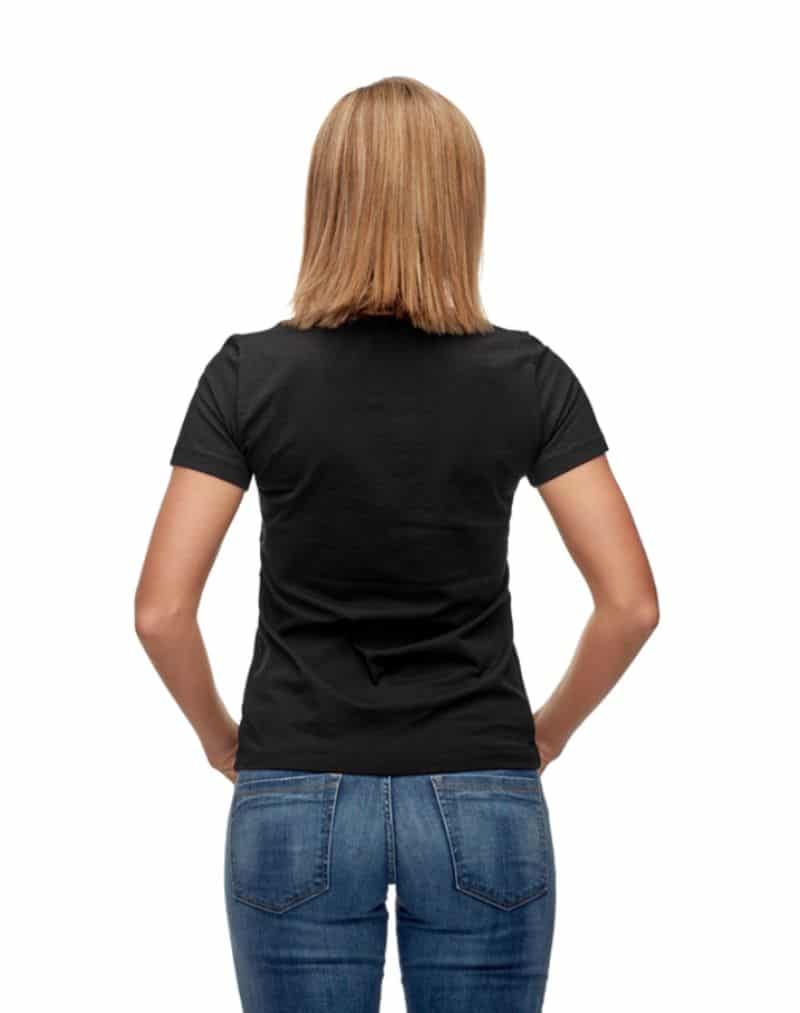
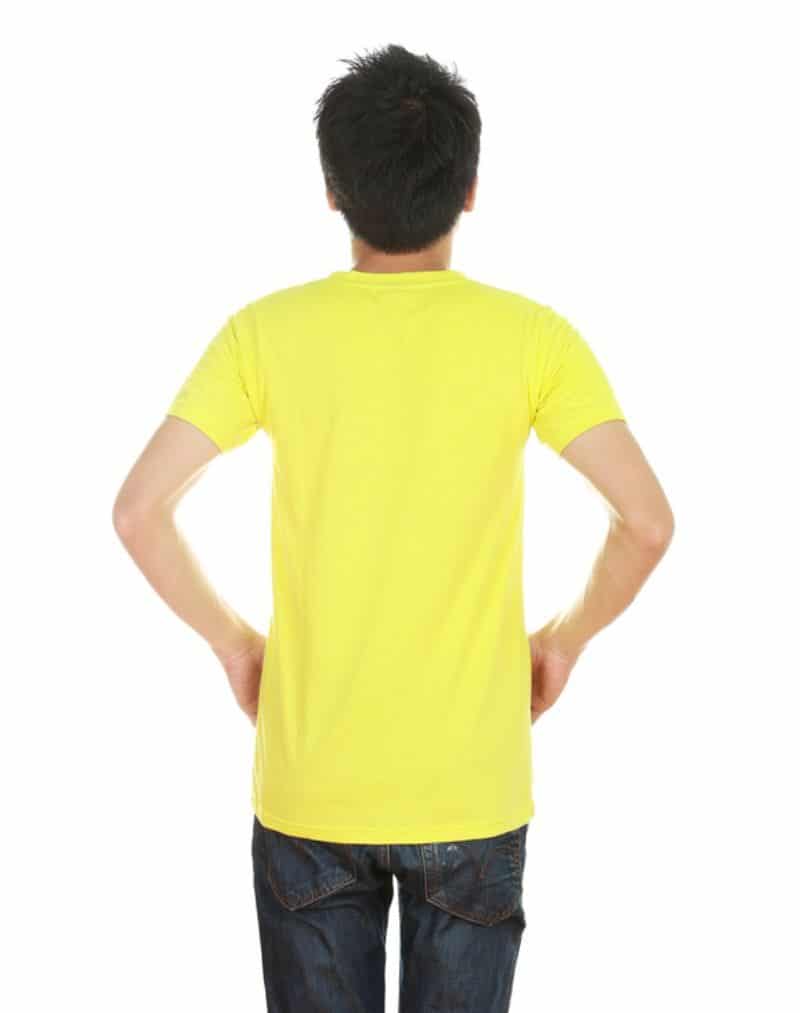
The design of a woman’s t-shirt goes beyond just the waist; it extends to how the t-shirt fits around the hips.
Women’s t-shirts are not just about a narrower waist. The design is further refined by introducing a slight flare towards the bottom. This means that instead of the t-shirt maintaining the same width from the waist down, it subtly widens at the bottom. This design element ensures that the t-shirt comfortably covers the hips without being overly tight or causing the material to bunch up. This attention to detail in the cut of the t-shirt enhances the overall fit and comfort, making it more suited to the female form.
Bust Accommodation: The Unique Aspect of Women’s T-shirts vs Men’s
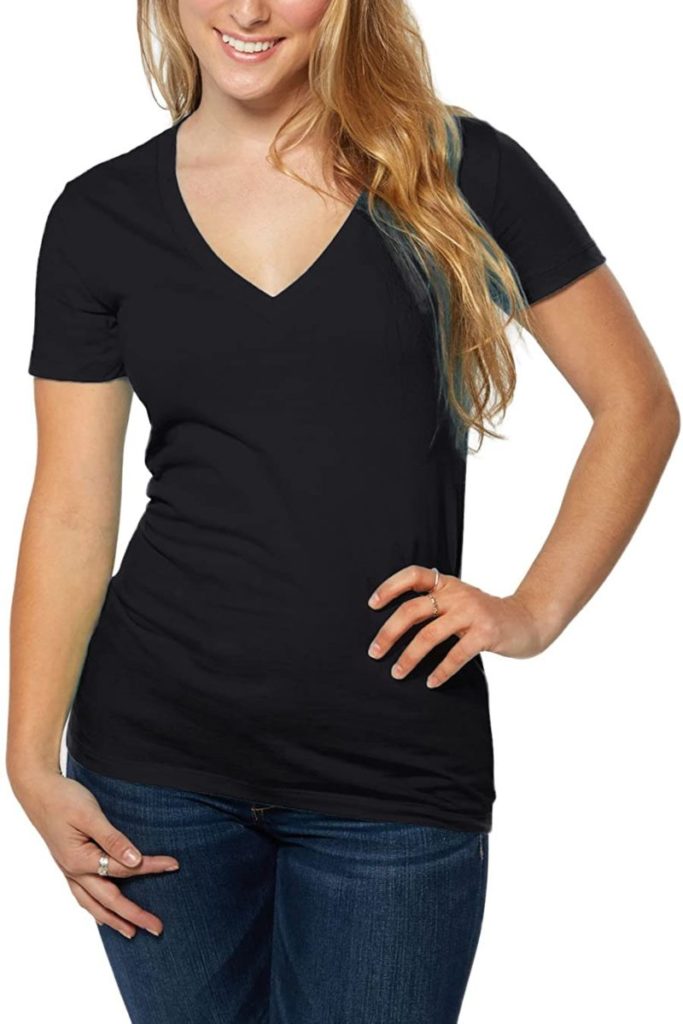
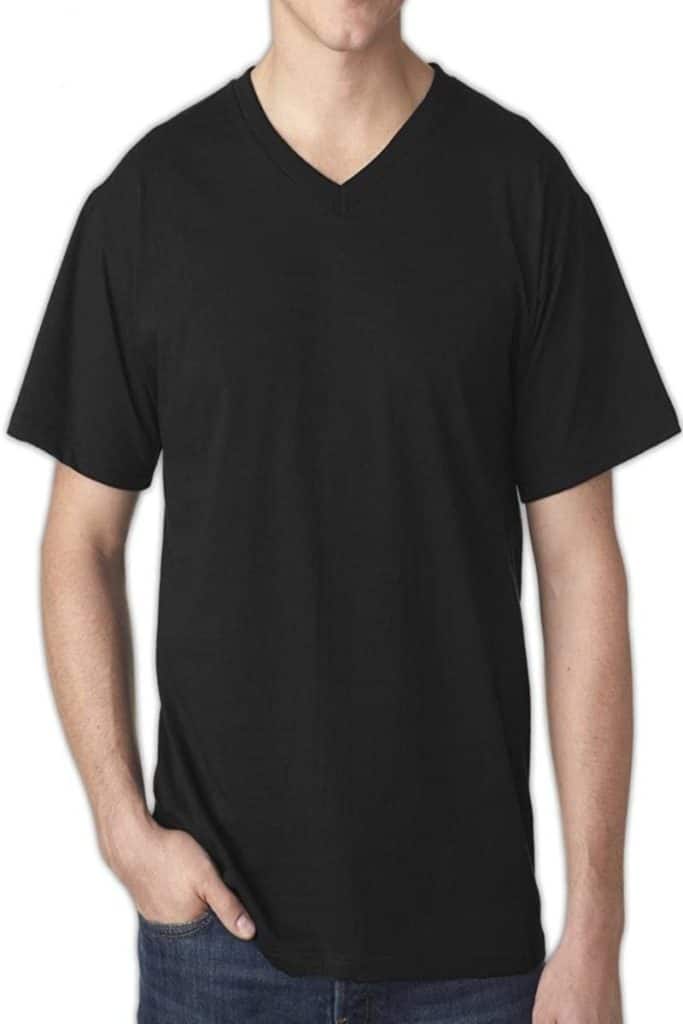
When wearing unisex t-shirts, women with larger busts will have the options of either a t-shirt that is far too tight and uncomfortable around the chest or one that leave a lot of unsightly loose material around the abdomen.
Women’s t-shirts are designed to incorporate bust sizes, meaning that they can have more material around the chest while still fitting appropriately and comfortably elsewhere, especially below the chest. Although separate sizing for busts, waists, and hips is uncommon in women’s t-shirts, the general addition of the bust adjustment leads to a much easier time finding the right fit for women.
How Unisex Shirts Fit on Women With a Larger Bust
Unisex shirts, which are typically designed based on men’s sizing and body shape, may not provide the best fit for women with a larger bust. They are often straight-cut from the chest to the waist, which can result in a looser fit around the waist. For women with a larger bust, this could mean that the shirt may fit well around the chest but appear baggy or shapeless around the waist.
Sleeve Length: Why Women’s Shirts Have Shorter Sleeves Than Men’s
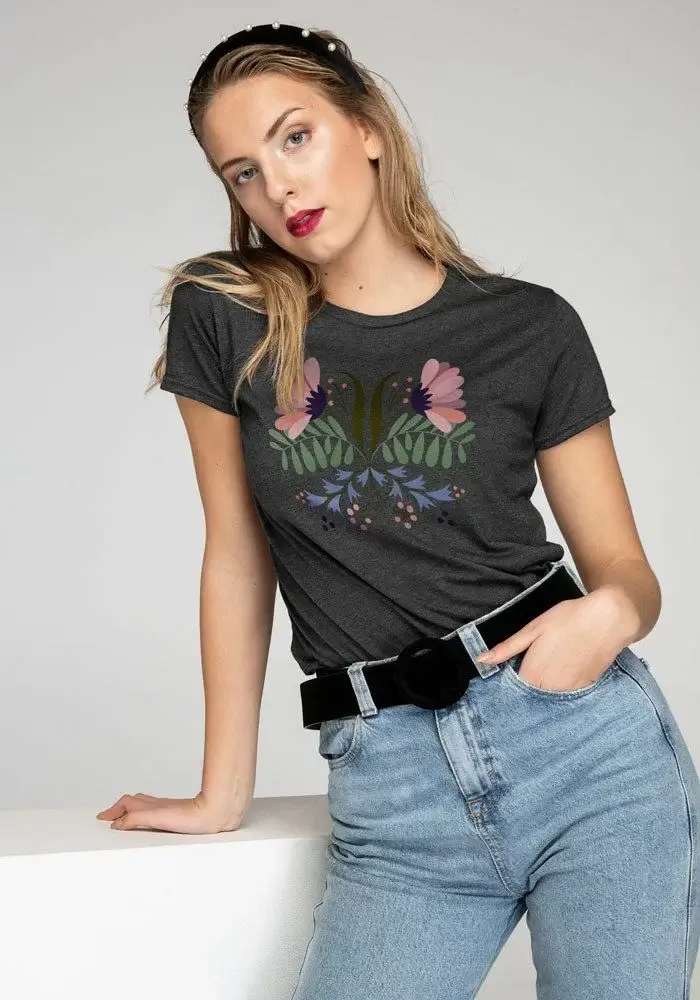
Men’s and unisex t-shirts will tend to have longer sleeves. This can be frustrating for smaller women who are after a short-sleeve t-shirt, only to find that the options they have available end up reaching their elbows.
Why are women’s sleeves shorter than men’s? Women’s sleeves are shorter than men’s because men tend to have longer arms. If the same dimensions for the sleeves were used for both shirts, the sleeves would look longer on a woman as opposed to a man.
The types of sleeves that are often found on women’s t-shirts are called cap sleeves, and they tend to be both shorter as well as a lot tighter fitting to accommodate the significantly slimmer arms that women have on average compared to men.
Neckline Styles: A Distinct Difference Between Men’s and Women’s T-shirts
The vast majority of men’s or traditional unisex t-shirts will have a rounded neckline that fits quite close around the neck. It is true that some t-shirts designed for men will have V-necks, but most of the variations in the necklines of t-shirts will be found in those designed for women.
The most common necklines that appear on women’s t-shirts are the V-neck and the deep-V. You can recognize these by looking for necklines that are lower at the front and meet in the middle at a sharp angle rather than a smooth rounding. The deep-Vs, as the name implies, meet in the middle much lower, leaving more of the throat and upper chest exposed.
Another type of neckline found in women’s t-shirts is the scoop neck. This neckline is rounded but is a lot lower than the traditional unisex t-shirt neckline. Square necklines emulate what you might find on certain dresses. By incorporating them into a t-shirt, you end up with a distinctly more feminine design.
Size Comparison: Women’s T-shirt Size vs Men’s
When it comes to t-shirt sizing, the ‘one size fits all’ approach of unisex t-shirts often falls short. This is primarily because men and women, on average, have different body dimensions. It’s not just about the waist-to-hip ratio, but also factors like height and shoulder breadth. For instance, men are typically taller and have broader shoulders than women. So, when a t-shirt is labeled as ‘medium’, it begs the question: medium for whom?
This is where the importance of distinct men’s and women’s t-shirt sizes comes into play. By differentiating between the two, manufacturers and retailers can provide more accurate sizing that aligns with the average body dimensions of each gender. This means when you pick up a women’s t-shirt labeled as ‘M’ for medium, you can confidently expect it to fit a medium-sized woman’s body, without the uncertainty of whether the sizing leans more towards men or women. This clarity not only simplifies the shopping process but also ensures a better fit for the wearer, enhancing customer satisfaction.
Fit: Women’s Fit vs Men’s Fit in T-shirts
This may seem like it is implied with the smaller size and different shapes, but women’s t-shirts have a more snug fit even separate from these other changes. Men’s t-shirts and the unisex t-shirts that were common before the development of women’s t-shirts tended to hang quite loose even on men. This was preferred by the men, but not so much by women.
Women’s t-shirts are designed with a more snug fit to accentuate the shape of the female torso much better. This creates a more feminine look to them, making the t-shirts aesthetic as well rather than simply practical.
Fabric Choice: How it Varies Between Male and Female T-shirts
Perhaps the most subtle difference and the one most frequently forgotten: men’s and women’s t-shirts tend to be made from different fabrics. Men’s t-shirts are generally made with thicker and rougher fabrics. Because of the difference in design, this can be very uncomfortable in women’s t-shirts around pressure points like the waist or armpits.
To accommodate this, women’s t-shirts will often be made with fabrics that are thinner and lighter. These will feel softer on the skin and therefore be less abrasive. These kinds of fabrics are also more breathable, meaning that more air can flow through them, preventing you from feeling stuffy or too warm.
Conclusion
Understanding the differences between men’s, women’s, and unisex t-shirts is crucial for anyone in the t-shirt selling business. From the cut of the waist and the flare at the hips, to the length of the sleeves and the style of the neckline, each detail is meticulously designed to cater to our distinct physical attributes. Even the sizing, overall fit, and the very fabric of the t-shirts are tailored to suit the needs of different genders.
As we’ve seen, women’s t-shirts are not just smaller versions of men’s t-shirts. They are designed with a narrower waist, a flare at the bottom, shorter sleeves, and a variety of neckline styles to accommodate the unique shape of the female body. On the other hand, men’s t-shirts are generally straight-cut with longer sleeves and a close-fitting round neckline.
Unisex t-shirts, while designed to be suitable for both genders, often lean more towards men’s sizing and fit. This means they may not provide the best fit for all women, especially those with a larger bust or narrower waist.
As a t-shirt seller, being aware of these differences can help you cater to your customers’ needs more effectively, provide accurate sizing advice, and ultimately sell more shirts. Remember, a well-fitted t-shirt not only looks good but also feels comfortable, leading to satisfied customers and repeat business. So, embrace these differences, educate your customers, and watch your t-shirt business thrive!
FAQs
How to tell if a T Shirt is male or female?
To tell if a t-shirt is male or female, look at the cut (waist), sleeve length, neckline styles, size, fit, and fabric.
Can a man wear a women’s shirt?
A man can wear a women’s shirt, although it will be very tight as the dimensions differ.
What is a women’s cut shirt?
A women’s cut shirt means that the shirt has been made specifically for women. This can include a narrower waist, tighter sleeves, and a larger chest width.
Bryan E. Robinson is the former owner of TshirtGrowth. He has sold t-shirts since 2006 through dropshipping, screen printing, vinyl printing, DTG, Print on Demand, and more. Bryan has created his own t-shirt designs through Photoshop, Canva, and other platforms, as well as worked with freelancers to create many of his designs. Besides t-shirts, Bryan has over 18 years of experience in online marketing with eCommerce, B2B SaaS, B2C products, and more.

